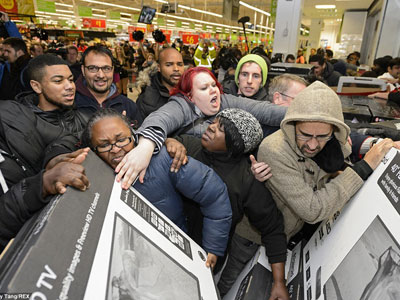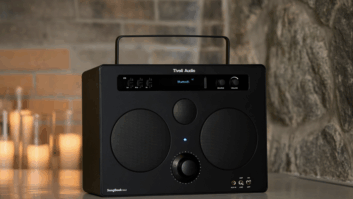
America’s annual rite of overindulgence has come and gone, leaving retailers to count their receipts and pundits to ponder the repercussions.
What’s become clear in the days following the long holiday weekend is that where, how and when shoppers shop has irrevocably changed, and Black Friday proper is quickly becoming a ghost of Christmas past.
Here then for your edification are TWICE’s Top Five takeaways from the Black Friday weekend:
- Black Friday Is Dead, Long Live Black Friday
Well, maybe not dead, but certainly diffused. Years in the making, Black Friday has finally succumbed to retailers’ efforts at extending the holiday shopping focal point with pre- and post-weekend promotions.
“Unlike 10 years ago, we live in a world in which you can shop anywhere at any time,” observed Matthew Shay, president/CEO of the National Retail Federation (NRF) trade group. “It’s no longer about one day, but a season of digital deals.”
Market research firm ShopperTrak concurred that the confluence of month-long promotions, Thanksgiving Day doorbusters, and the advent of mobile shopping has taken a big bite out of the traditional brick-and-mortar Black Friday (see p. 27), with total in-store sales down 11.9 percent, to $10.2 billion, on the day after Thanksgiving.
“Fewer visits … reinforce the trend we’ve seen throughout the year, in which shoppers are researching products ahead of time, targeting their store visits, and arriving in-store with the intention of making a purchase,” observed ShopperTrak’s chief revenue officer Kevin Kearns. “And from our data, we saw greater retail sales generated prior to the Black Friday weekend, which is a result of retailers successfully elongating the holiday season.”
The one exception may be CE. According to Google data, CE specialty and cellular stores still see the biggest one-day sales volume on Black Friday (see graphic), although all other retailers reap the biggest sales rush from last-minute Christmas shoppers.
- Thanksgiving’s No Turkey
Despite a family-values backlash and a growing list of major retailers (46 and counting) who kept their doors closed on Thanksgiving, the consumer has demonstrated his and her propensity to shop on the national holiday.
True, store traffic may have ebbed from last year (see item above), but that didn’t stop shoppers from sneaking away from the dinner table to place their discounted orders. According to digital analytics company comScore, Thanksgiving Day retail sales placed from desktop computers alone hit nearly $1.1 billion, up 9 percent over last year.
Observed comScore chairman emeritus Gian Fulgoni: “This is the second straight year that Thanksgiving has established itself as one of the more important online buying days.”
- Shoppers Were Mobilized
M-commerce clearly reached a tipping point over the holiday weekend as shoppers let their fingers do the walking via smartphones and tablets. According to an IBM Watson Trend report, mobile accounted for 36.2 percent of all online sales on Black Friday and more than 57 percent of retailers’ site traffic, while Adobe’s Digital Index pegged Cyber Monday’s share of mobile sales at 26 percent and shopping visits at 44 percent.
Observed Adobe Digital principal analyst Tamara Gaffney, “U.S. consumers have turned into digital shopping ninjas this holiday season as retailers continue to adjust to a huge influx of smartphone shoppers.”
Fernando Madeira, president/CEO of Walmart.com, concurred. “Mobile firmly established itself as the dominant shopping trend for both traffic and sales,” he said. “Our customers went from previously mostly searching and browsing on mobile to making purchases at a much higher rate.”
Indeed, more than 70 percent of site traffic and nearly half of all orders — an increase of 100 percent over last year — originated from mobile devices between Thanksgiving and Cyber Monday, he noted.
- Social Media Just Meh
Despite all the corporate emphasis on tweeting, snapchatting, messaging and pinteresting, social media spurred only 1.5 percent of online orders on Cyber Monday. According to retail analytics firm Custora, retailers got a bigger bang for their bucks from email marketing (accounting for 22.1 percent of sales), free search (20.7 percent) and paid search (16.6 percent).
But regardless of what motivated their customers, e-tailers racked up a record $3.07 billion in revenue on Cyber Monday, Adobe said, making it the largest online sales day ever, and forcing Target to slow down transactions to avoid a digital meltdown.
- The CE Industry’s Death Wish
First the good news: Tech is still tops with holiday shoppers. According to the Consumer Technology Association (CTA), electronics were a driving force behind the holiday weekend’s sales, with some 57 million Americans, or 45 percent of adults, buying or planning to buy tech products.
And don’t just take it from the industry’s trade group; CE made the top-seller lists of nearly every general merchant, including Target. The discounter cited iPads (one sold every second on Thanksgiving); gaming consoles (Nintendo Wii U was its top-selling item online on Black Friday); and TVs (“one of the most sought-after items in stores”) ahead of all else.
Which makes the bad news all the more sorrowful. The beaten-down TV business is finally making a comeback with 4K displays, but before you can say “margins,” these four-figure marvels were price-slashed for the weekend, with Samsung’s 60-inch UHD stunner selling widely for $800.
Sure, you can argue that it was just a limited-time promotion that will help drive mainstream adoption of these advanced TVs. But as newly-minted CE Hall of Famer and vociferous 4K advocate Tom Campbell of Video & Audio Center reminded, once the consumer gets that price point in his head, there’s no going back.
“We really do eat our young,” he said.













